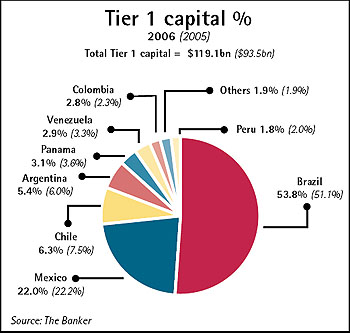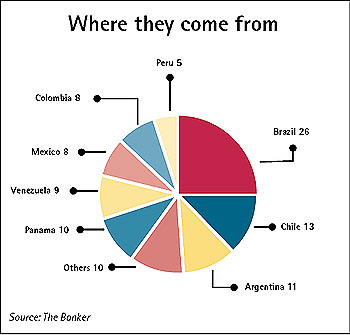Brazil’s banks dominate the listing with their healthy assets and profitability, and Mexico also does well.
The robust health of the Brazilian economy has contributed to the continued dominance of Brazilian banks in our listing of the Top 100 Banks in Latin America, with 26 banks that between them account for the following shares in the aggregate figures: Tier 1 capital 53.8%, assets 54.5%, and pre-tax profits 52.3%.
As reported in July’s The Banker (page 82), lending in Brazil, particularly consumer credit, has taken off despite high costs, and the mortgage market is, as yet, largely untapped. A downward movement in interest rates, especially to single digits, is likely to trigger a surge in this sector that will further add to banking sector assets and profitability.
Mexico’s eight banks in the listing contributed 22%, 15.2% and 25.9% of the same aggregates. Numerically stronger countries, such as Chile (13 banks), Argentina (11) and Panama (10), had only single-digit shares in the aggregates. The aggregate total for the Top 100 for Tier 1 capital was $119.1bn, up 27.4%, while assets grew 29.0% to $1419.6bn. Pre-tax profits increased by 9.9% to $33.2bn. For comparison, the consolidated figures for Bank of America at year-end 2006 were Tier 1 capital $91.1bn, assets $1459.7bn and pre-tax profits $32.0bn.
The composition of the top 10 is the same as last year, with seven Brazilian and three Mexican banks. Banco Itaú Holdings moves back to the top, having ceded that position to Banco Bradesco last year, and Banco do Brasil is in third place. In fourth place is Banamex, just ahead of BBVA Bancomer, again a reversal of last year’s positions.
Argentine reversal
Argentinian banks seem to be reversing the downward trend of the previous years as the economy booms. Banco de la Nación Argentina moved up one place to 14 this year following a 21% increase in Tier 1 capital, and Banco Macro moved from 43 to 28 as its Tier 1 capital rose 97.8% following its acquisition of Banco del Tucumán.
There are eight new entries to this year’s list, headed by Brazil’s Banco ibi, primarily a consumer finance bank that is part of the C&A retail group, at 73. Banco Comercial AB Villas from Colombia is the next highest new entry at 76, followed by Belize Bank Holdings at 79. Scotiabank El Salvador enters at 88, following the completion of its merger with Banco de Comercio de El Salvador and Brazil’s Banestes (Banco do Estado do Espírito Santo) is at 89, followed by Banco de Crédito-Helm Financial Services from Colombia at 90. The new entries are completed by Panama’s Caja de Ahorros at 98 and Venezolano de Crédito (Venezuela) at 99.
Thirty-one of the Top 100 banks are foreign-owned, 29 by single banking entities, and two either by banking consortia or non-banking companies. BBVA and Santander have long been investors in Latin American banking, as has Scotiabank. In 2006, HSBC increased its holdings in the region by acquiring the Panamanian-based Banistmo group, headed by Primer Banco del Istmo, and then Banco Salvadoreño in El Salvador.
The main focus of attention in the region, and especially in Brazil, is on the outcome of the takeover battle for ABN AMRO. If the Royal Bank of Scotland/Fortis/Santander consortium wins then ABN AMRO’s Latin American holdings will transfer to Santander, including Banco ABN AMRO Reál in Brazil. With Santander’s existing Brazilian operation, this will create a bank to rival the Brazilian big three of Itaú, Bradesco and Banco do Brasil.




